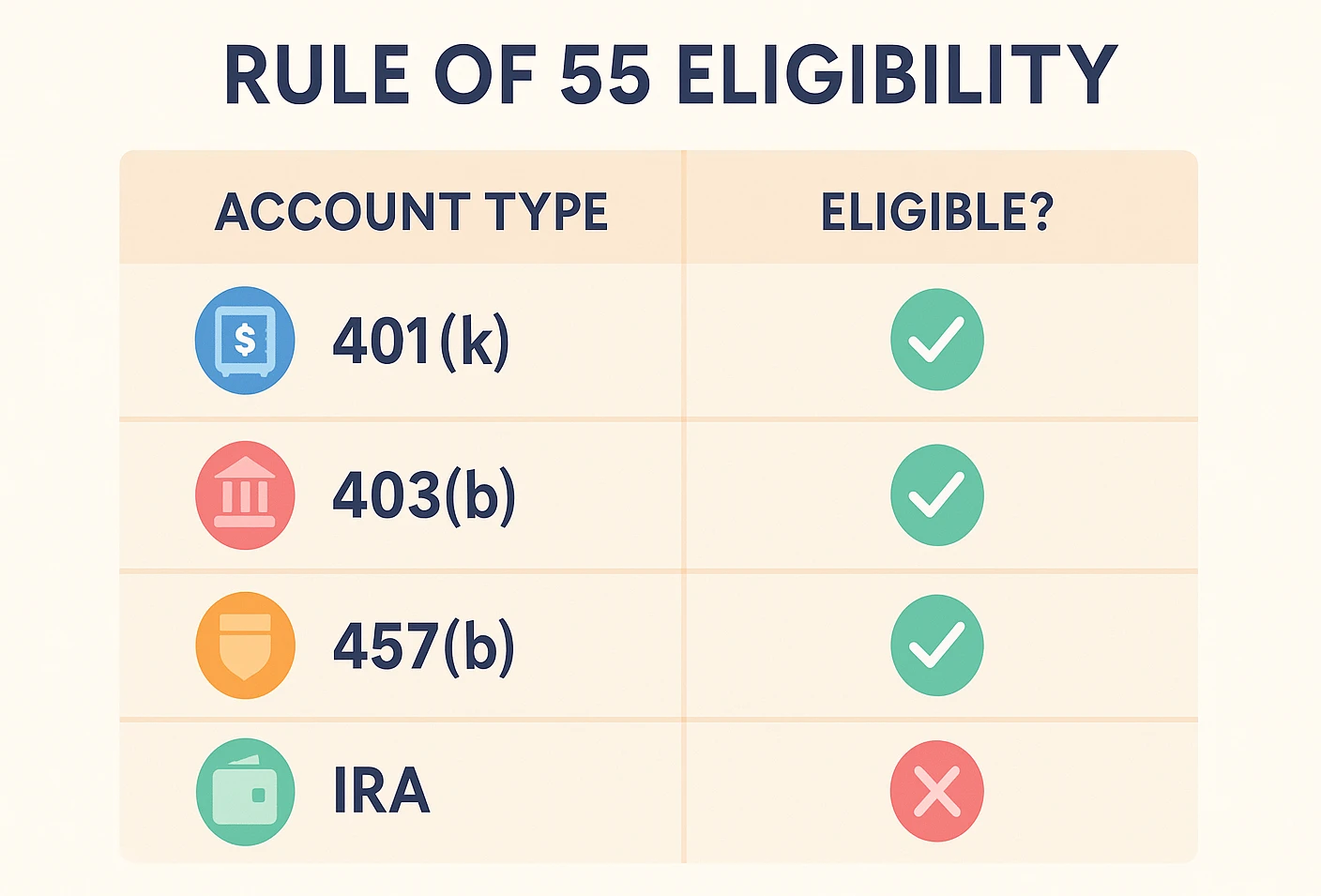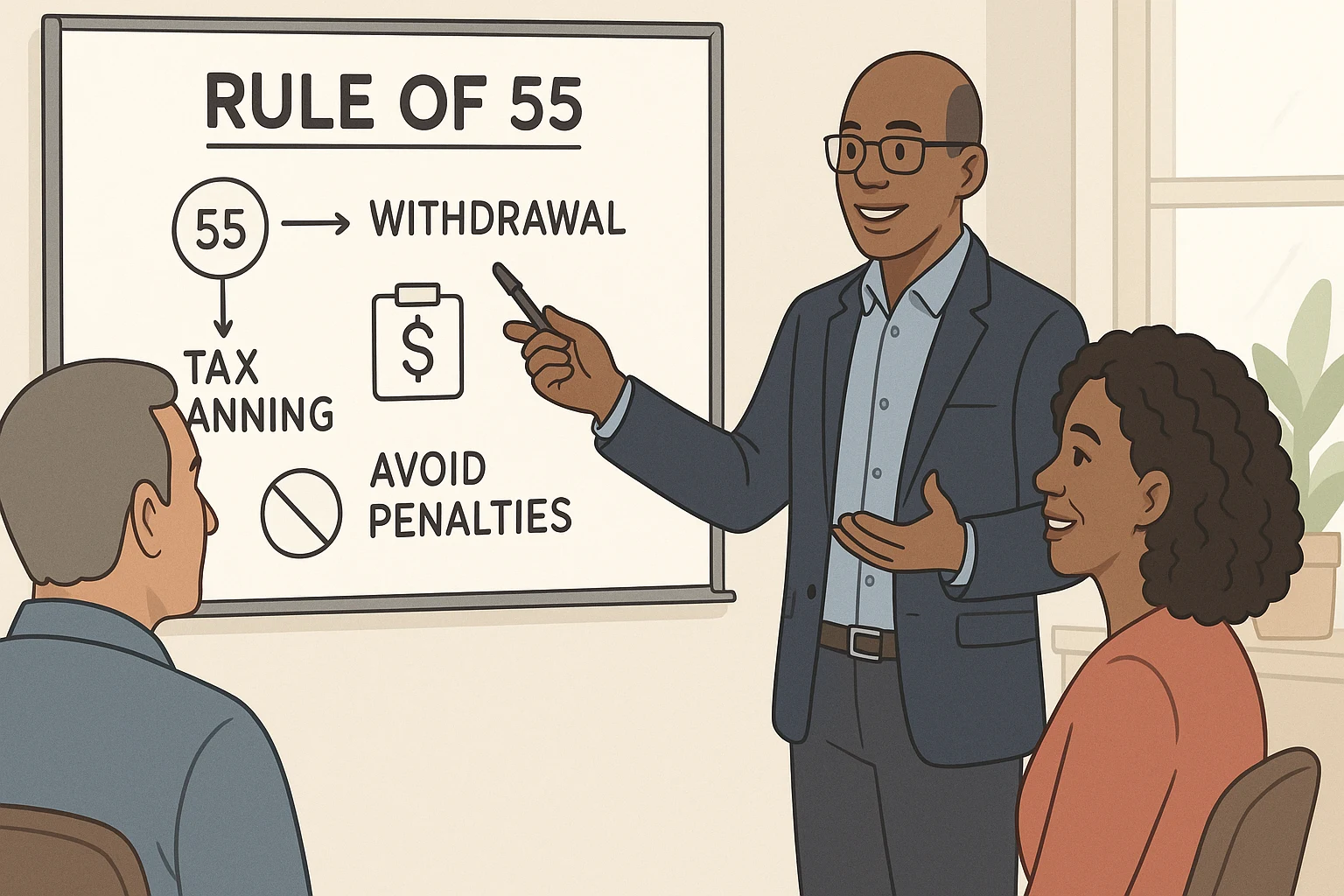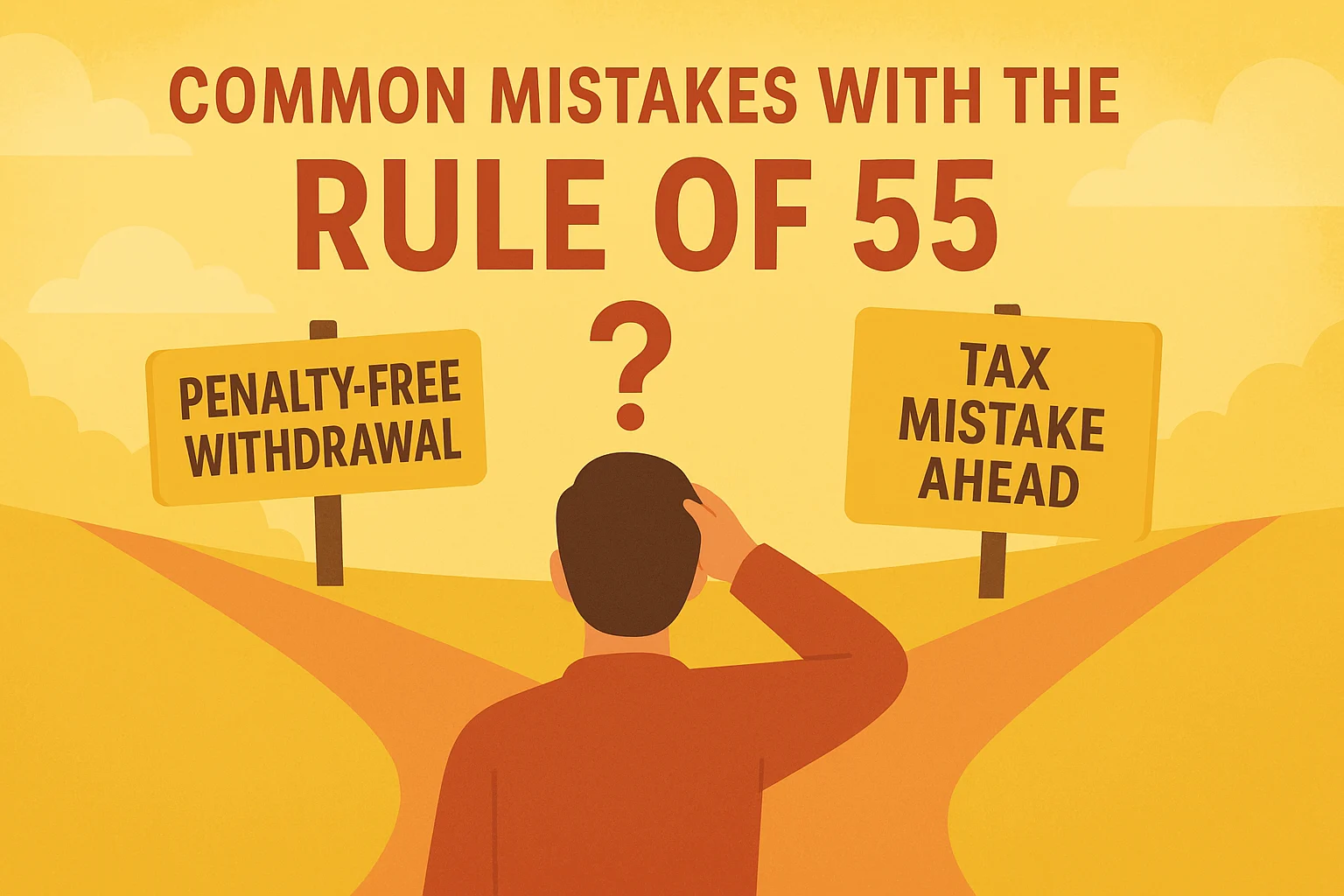
Retire 4 years early! The early retirement Rule of 55 is a little-known IRS loophole that unlocks your 401(k) penalty-free at 55. For many over 35 chasing the FIRE movement, leaving work before 59½ is the dream. Tapping retirement accounts early often means a 10% penalty, but this rule changes that. Picture your first penalty-free withdrawal funding a dream vacation or a stress-free life abroad—freedom starts now!
This guide dives deep into this IRS provision, covering eligibility, steps, and mistakes to avoid. We’ll share real-life stories and a calculator to see if this rule can fuel your tax-free retirement dreams. Let’s get started!
Check Your Rule of 55 Eligibility!Rule of 55 Eligibility Tool
Rule of 55 Eligibility Checker
Find out if you qualify for penalty-free 401(k) withdrawals with this tool.
*Disclaimer: This tool provides general information and is not financial or tax advice. Always consult a qualified financial advisor and your plan administrator.
Table of Contents
- Key Takeaways of the Rule of 55
- What Is the Early Retirement Rule of 55?
- How to Use the Early Retirement Rule of 55: Step-by-Step
- Key Nuances of the 55-and-over 401(k) exception
- Tax and Investment Considerations
- Real-Life Examples: How the Rule Works
- Avoid These Mistakes with the Early Retirement Rule of 55
- How This Rule Fits Into Your FIRE Strategy
- Frequently Asked Questions About the Rule of 55
- Conclusion: Unlock Your Early Retirement Dreams
Key Takeaways of the Rule of 55
- Penalty-Free Access: The Rule of 55 allows penalty-free withdrawals from your current employer’s 401(k), 403(b), or 457(b) plan if you leave your job in the year you turn 55 (or 50 for public safety employees). 📅
- Eligibility Matters: You must separate from service at or after age 55. Leaving earlier disqualifies that plan.
- Current Plan Only: This applies only to the retirement plan of the employer you’re leaving, not old 401(k)s or IRAs. Rolling funds to an IRA too soon voids eligibility! 🚫
- Taxable Income: Withdrawals are penalty-free but subject to ordinary income tax. Plan accordingly! 💰
- Consult Experts: Always check with your plan administrator and a tax advisor to ensure compliance and fit for your situation. ✅

What Is the Early Retirement Rule of 55?
The Rule of 55 is an IRS exception that lets you avoid the 10% penalty on early withdrawals from qualified retirement plans. Normally, taking money from a 401(k) before age 59½ triggers income tax plus a 10% penalty. However, this exception, outlined in IRS Section 72(t), allows penalty-free withdrawals if you leave your job in the year you turn 55 or later, making it a key tool for the FIRE movement.
“The early retirement Rule of 55 is like a bridge, helping you cross from your career to a tax-free retirement without losing 10% to penalties.”
Who Qualifies for the Rule of 55?
To use the rule, you must meet two key conditions:
- Age Requirement: Separate from service (retire, quit, or get laid off) in the calendar year you turn 55 or later. For instance, if you turn 55 in December 2025 but leave in January 2025, you qualify. Leaving in December 2024 (at 54) disqualifies that plan.
- Separation from Service: You must no longer work for the employer sponsoring the plan you’re accessing.
Understanding Separation from Service for Early Retirement
The separation requirement is critical for early withdrawal strategies. You must end employment with the company offering the retirement plan. Whether you retire, quit, or are laid off doesn’t matter—only that your employment ends. For example:
- Scenario A: Sarah, 54, quits on December 31, 2024, and turns 55 on January 15, 2025. She doesn’t qualify for the Rule of 55 for her employer’s 401(k) because she left before the year she turned 55.
- Scenario B: Mark, 54, turns 55 on July 1, 2025, and quits on August 1, 2025. He does qualify because he left in the year he turned 55.
Timing matters; plan your exit so your separation date clearly falls in the qualifying year.
Which Accounts Qualify for the Early Retirement Rule of 55?
Not all retirement accounts are eligible. The Rule of 55 applies only to:
- 401(k) Plans: From your current employer.
- 403(b) Plans: Common for public school or nonprofit employees.
- Governmental 457(b) Plans: For state or local government workers.
Important: The rule applies only to the plan of the employer you’re leaving. Old 401(k)s from past jobs or IRAs (Traditional, Roth, SEP, or SIMPLE) don’t qualify.
| Account Type | Rule of 55 Eligibility (if separated at/after age 55) |
|---|---|
| Current Employer 401(k) | ✅ YES |
| Current Employer 403(b) | ✅ YES |
| Current Employer 457(b) | ✅ YES (Governmental only) |
| Old 401(k) from previous job | ❌ NO |
| Traditional IRA | ❌ NO |
| Roth IRA | ❌ NO |
| SEP IRA / SIMPLE IRA | ❌ NO |
How to Use the Early Retirement Rule of 55: Step-by-Step
Ready to tap your 401(k) penalty-free? Here’s how to make this rule work for you, step by step.
Step 1: Leave Your Job at or After Age 55
First, you need to leave your job in the year you turn 55 or later. For example, if your 55th birthday is October 20, 2025, quitting any time in 2025 works. If you leave in 2024, it won’t count.
What to do: Double-check your birth date and when you plan to leave your job to make sure you qualify.
Step 2: Look Into Your Plan’s Details
The IRS is cool with penalty-free withdrawals, but your employer’s plan might have some quirks, like holding off on payments or limiting how you can take your money.
What to do: It’s worth contacting your plan administrator—HR or the company managing your plan (e.g., Fidelity). Helpful questions include:
- “What options do I have for withdrawals at 55?”
- “Does my plan allow Rule of 55 withdrawals?”
- “What paperwork or steps do I need to follow?”
Tip: Do this before you quit to avoid any surprises down the road.
Plan Your Rule of 55 for Early Retirement Strategy
Figure out how much money you want to pull out and when. Say you withdraw $50,000 a year at a 22% tax rate—that’s $11,000 in taxes, leaving you with $39,000 for things like bills, travel, or whatever you’re dreaming of in retirement. Here’s what to think about to keep your retirement plan on track:
- Your Needs: How much cash do you need for everyday stuff, like your mortgage or that trip you’ve been planning?
- Taxes: Pulling out money bumps up your taxable income. Taking smaller, steady amounts might keep you in a lower tax bracket, saving you some cash.
- Investments: Make sure what’s left in your 401(k) fits your big-picture goals, so it keeps growing for your future.
What to do: Team up with a financial advisor to juggle your income, taxes, and growth plans. For extra help with taxes, check out IRS guidelines.
Step 4: Request Your Withdrawals
Once you’re eligible, it’s time to get your money from your plan administrator.
What to do: Fill out the necessary forms, choose how you want the money sent (like direct deposit), and be ready for 20% federal tax withholding. Hang onto records, like Form 1099-R, for tax season.

Key Nuances of the 55-and-over 401(k) exception
Missing these details could derail your early withdrawal strategies, so let’s break them down carefully.
Current Employer Plan Limitation
The Rule of 55 applies only to the plan of the employer you’re leaving at 55 or older. Old 401(k)s or IRAs don’t qualify. For example, if you leave Company B at 56, you can access Company B’s 401(k) penalty-free, but not a 401(k) from Company A left years ago. Some plans allow partial withdrawals, letting you take $10,000 yearly while keeping the rest invested, but confirm with your administrator.
Avoid Rolling Over to an IRA Too Soon
Rolling your 401(k) into an IRA before taking Rule of 55 distributions makes those funds ineligible. Think of your 401(k) as a special key—once it’s an IRA, the lock changes.
Special Rule for Public Safety Employees
Qualified public safety employees (e.g., police, firefighters, EMTs) can use the Rule of 55 at age 50 if they leave their governmental employer. This applies only to that employer’s 457(b) or other qualified plan, offering a unique path to early retirement savings.
Tax and Investment Considerations
Taxes and long-term growth are critical when using this rule. Here’s what to keep in mind.
Taxes Still Apply
Withdrawals are penalty-free but taxable as ordinary income. For example, a $20,000 withdrawal at a 24% tax rate incurs $4,800 in federal taxes, reducing your usable funds. Careful planning helps you avoid a surprise tax bill during your tax-free retirement journey.
Roth 401(k) Simplified
For Roth 401(k)s, the Rule of 55 waives penalties, making it a powerful early withdrawal strategy. Think of a Roth 401(k) as a tax-free piggy bank: contributions come out tax- and penalty-free anytime, but earnings are taxable unless the account is 5 years old and you’re 59½.
Long-Term Impact on Early Retirement Savings
Early withdrawals reduce your nest egg’s growth potential. For instance, a $50,000 withdrawal at 55 could be worth $80,000 by 65 at a 5% annual return. To protect your financial future, consult an advisor to ensure your funds last through your retirement planning years.
Real-Life Examples: How the Rule Works
Let’s see how the Rule of 55 works in practice with stories from real people.
Example 1: The Early Retiree (Eligible)
David, 55, a marketing manager, retired in July 2025 after turning 55 in June. He withdraws $40,000 yearly from his current employer’s 401(k), paying $8,800 in taxes (22% rate) but no penalty. His early withdrawal strategy funded a dream vacation! ✅
Example 2: The Job Hopper (Ineligible)
Maria, 57, retired from Company B in 2025. She can access Company B’s 401(k) penalty-free but not her old Company A 401(k) from years ago, which is still subject to the 59½ rule. She’s now exploring other early retirement savings options. ❌
Example 3: The Firefighter (Eligible at 50)
Captain Jones, a 50-year-old firefighter, retired in 2025. As a public safety employee, he withdraws from his 457(b) plan penalty-free, paying only income tax. This jumpstarted his tax-free retirement! ✅

Avoid These Mistakes with the Early Retirement Rule of 55
Steer clear of these common pitfalls to protect your early retirement savings.
- Wrong Timing: Leaving at 54, even a month before turning 55, disqualifies you. Wait until the year you turn 55.
- Premature IRA Rollover: Rolling to an IRA before withdrawals voids Rule of 55 eligibility.
- Assuming All Accounts Qualify: Only current employer plans are eligible, not old 401(k)s or IRAs.
- Ignoring Taxes: Plan for income taxes to avoid a big tax bill.
- Skipping Plan Rules: Confirm distribution options with your plan administrator.
Frequently Asked Questions About the Rule of 55
How This Rule Fits Into Your FIRE Strategy
The Rule of 55 is a cornerstone for those pursuing Financial Independence, Retire Early (FIRE). Whether you’re aiming to quit your 9–5 or just want a few extra years of freedom, this rule can be your launchpad. Unlike Roth IRA conversions, which require years to build tax-advantaged income, the Rule of 55 offers immediate access to your 401(k) at 55 (or 50 if you’re a public safety worker). Unlike the 72(t) SEPP, which ties you to fixed payments for at least five years or until you hit 59½, the Rule of 55 gives you more flexibility. For instance, someone chasing FIRE might pull $30,000 a year from their 401(k) to bridge the gap until other investments kick in. Pair this with taxable accounts or part-time income to cover taxes and sustain your lifestyle.
Conclusion: Unlock Your Early Retirement Dreams
The early retirement Rule of 55 is a powerful tool for accessing your 401(k), 403(b), or 457(b) penalty-free at 55 (or 50 for public safety workers). It’s like a key to your early retirement savings, but only for the plan of the employer you leave. With careful planning, you can fund your dream retirement—whether that’s traveling the world or relaxing at home—without IRS penalties.
However, taxes still apply, and rolling funds to an IRA too soon can lock you out. To succeed:
- Contact your plan administrator to confirm distribution rules.
- Consult a financial advisor to align withdrawals with your FIRE goals.
- Work with a tax professional to manage tax liabilities.
With this provision, you’re one step closer to financial freedom. Start planning your tax-smart retirement today! ✅
This content is for informational purposes only and not financial advice. Consult a professional before making financial decisions.

